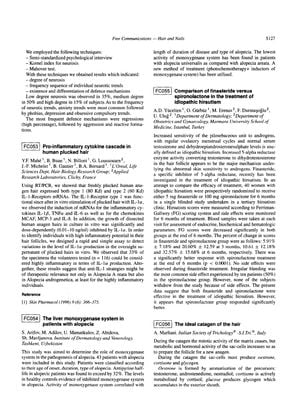FC056 The Ideal Catagen of the Hair
September 1997
in “
JEADV. Journal of the European Academy of Dermatology and Venereology/Journal of the European Academy of Dermatology and Venereology
”
IL-1-Receptors IL-1a inflammatory cytokines chemokines anagen hair Alopecia Areata Alopecia Androgenetica monoxygenase system alopecia universalis photochemotherapy finasteride spironolactone idiopathic hirsutism catagen phase oestrone cortisone glycogen sac-cells cellular apoptosis IL-1 inflammation hair growth phase hair loss liver enzyme system hair loss treatment Propecia Aldactone hair thinning hair cycle phase hormones sugar storage cell death

TLDR Blocking IL-1 could help treat some hair loss conditions; alopecia affects liver detox systems; spironolactone is better than finasteride for female hair growth; focusing on the catagen hair phase could lead to new alopecia treatments.
In the study "FC053 Pro-inflammatory cytokine cascade in human plucked hair," researchers from L'Oreal and Applied Research Laboratories in France used RT/PCR to demonstrate that freshly plucked human anagen hair expressed IL-1-Receptors mRNAs. They found that in vitro stimulation with IL-1a induced the production of inflammatory cytokines and chemokines and inhibited the growth of human anagen hairs. A rapid assay was designed to detect IL-1a production in plucked hairs, revealing that 33% of the 116 specimens tested showed high inflammatory potential. These findings suggest that anti-IL-1 strategies could be therapeutically relevant for certain individuals with Alopecia Areata and Alopecia Androgenetica.
In "FC054 The liver monoxygenase system in patients with alopecia," a study involving 43 patients with alopecia, researchers found that the antipyrine half-life in patients exceeded that of healthy controls by 32%, indicating an inhibited monoxygenase system in alopecia. The activity of this system correlated with the duration and type of alopecia, with the lowest activity in patients with alopecia universalis. A new treatment method combining photochemotherapy and inducers of the monoxygenase system was utilized.
"FC055 Comparison of finasteride versus spironolactone in the treatment of idiopathic hirsutism" involved a single-blinded study with 40 women with idiopathic hirsutism, randomized to receive either 5 mg finasteride or 100 mg spironolactone for 6 months. Both treatments were effective, but spironolactone showed a significantly better response at the end of 6 months, despite irregular bleeding being a common side effect in the spironolactone group.
Lastly, "FC056 The ideal catagen of the hair" discussed the catagen phase of hair, where mitotic activity ceases but metabolic and hormonal activity increases to prepare the follicle for a new anagen phase. The study emphasized the importance of oestrone, cortisone, and glycogen production by sac-cells during catagen, and suggested that understanding the genetic program of cellular apoptosis during catagen could lead to new treatments for alopecia. The document recommended focusing medical attention on the catagen phase rather than the anagen phase for treating alopecias.




